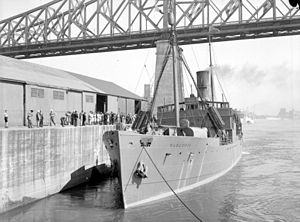SS Nascopie
 Nascopie in the Port of Montreal, 1945
| |
| History | |
|---|---|
| Name | RMS Nascopie |
| Owner | Hudson's Bay Company |
| Ordered | 6 March 1928 |
| Builder | Swan Hunter and Wigham Richardson, Newcastle upon Tyne |
| Launched | December 7, 1911 |
| In service | 1912 |
| Identification | |
| Nickname(s) | Eastern Arctic Patrol |
| Fate | Wrecked July 21, 1947 |
| General characteristics | |
| Tonnage | 2,521 GRT |
| Length | 285.5 ft (87.0 m) |
| Beam | 43.5 ft (13.3 m) |
| Draft |
|
| Installed power | 1x 3-cyl. triple expansion steam engine, single shaft. Output: 342 nhp |
| Propulsion | 1 screw |
| Speed | 14.1 knots |


Nascopie was fitted with an ice breaker bow and her plates were of five-eighths-inch steel. She carried Marconi apparatus located beside the wheelhouse on the upper deck. Her maiden crew was from the Dominion of Newfoundland under Captain Smith and they sailed for Penarth, South Wales, in late January 1912 to take on a load of coal bound for St. John's, Newfoundland. That winter she was employed in the annual seal hunt of the coast of Newfoundland under Captain Barbour for the Job Brothers mercantile business at St. John's.
Soon after
In 1916, when chartered by the government of France, and carrying cargo from

George E. Mack (1887–1941) a keen amateur photographer, joined the HBC in 1910, he served on the Nascopie twice, firstly as Second Officer in 1912, then again as Captain from 1915 to 1920; first as Master and then as Ice Master/Pilot, when he became a Superintendent of the Hudson's Bay Company from 1920 to 1928.[2] He took many photographs of the local communities the ship visited.
In 1934 Nascopie took for the first time a Governor of the company to ever visit Hudson Bay. HBC Governor Patrick Ashley Cooper and his wife joined her in Montreal and sailed as far as Churchill. In 1937, the ship enabled the Hudson's Bay Company in establishing Fort Ross. Sailing from the east, she met the schooner Aklavik, which had sailed from the west into Bellot Strait. This meeting of the two ships at Fort Ross, brought into reality for the first time the Northwest Passage.[3]
During the second World War, she was fitted with anti-aircraft gun, and a 3.7 inch Naval gun, she was used to ship carry
Nascopie was wrecked near
References
- ^ a b c d
"Our History: Transportation & Technology: R.M.S. Nascopie". HBC Heritage. Retrieved 2017-04-29.
Named after First Nations people of Quebec and Labrador, Nascopie was designed and built in England at Wallsend on Tyne in 1911.
- ^ a b "George Edmund Mack" (PDF). Hudsons Bay Company, Winnipeg Archives. Retrieved 26 March 2019.
- ^ a b "History of the R.M.S. Nascopie". HBC Heritage. Retrieved 26 March 2019.
External links
https://wantedonthevoyage.blogspot.com/2023/07/arctic-lifeline-hbss-nascopie.htmlcomprehensive design and operation history of the Nascopie with many photographs
